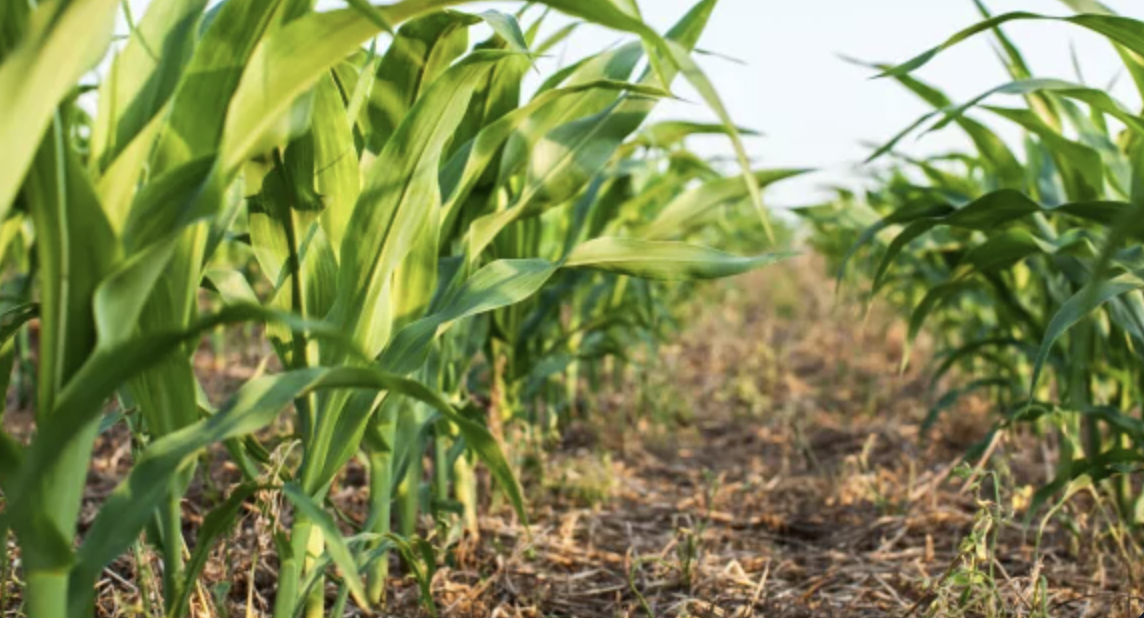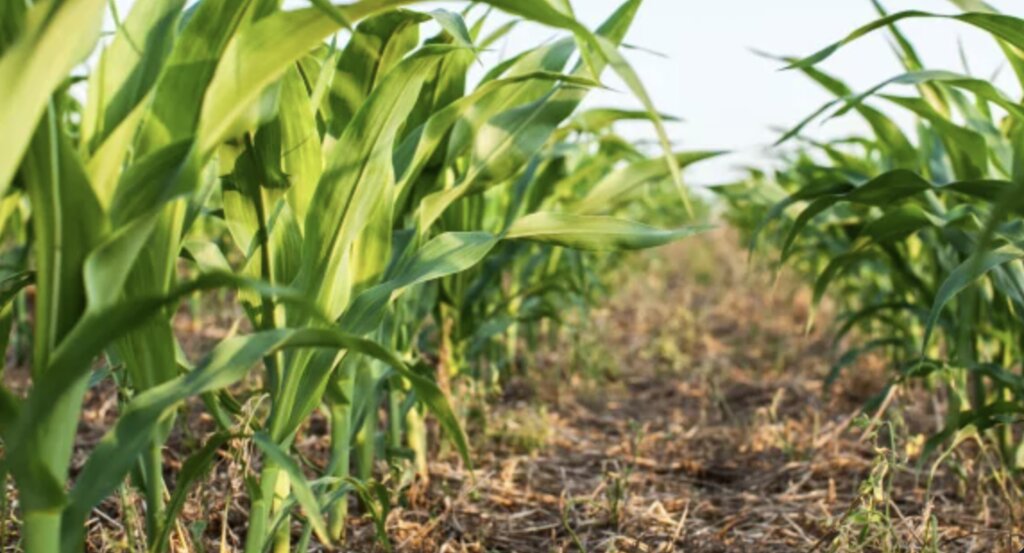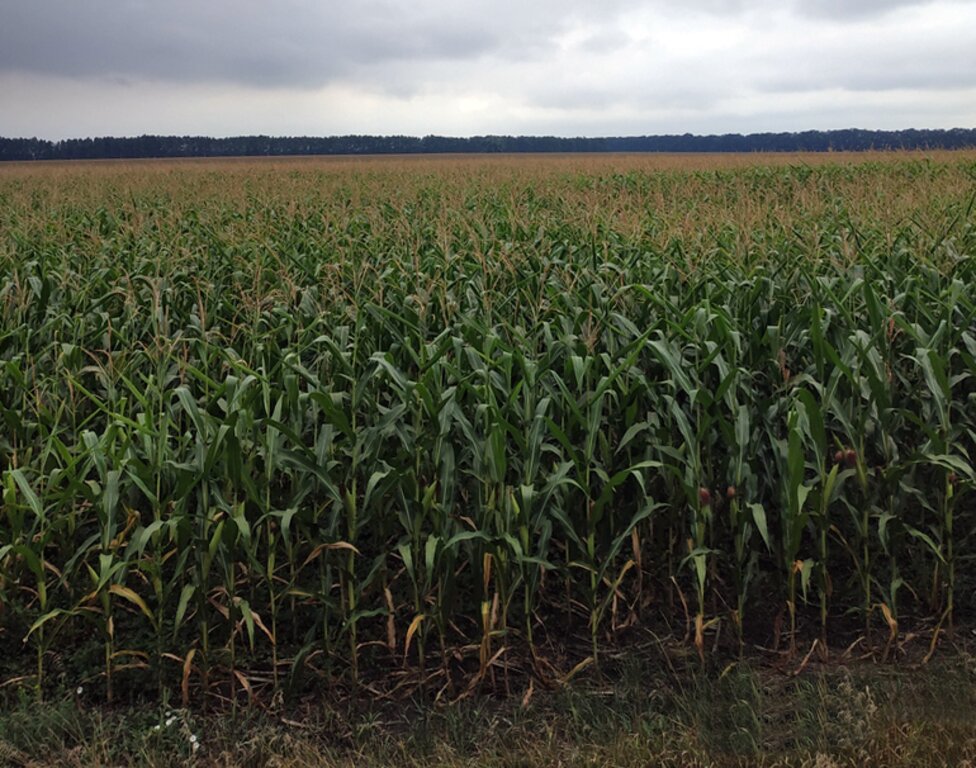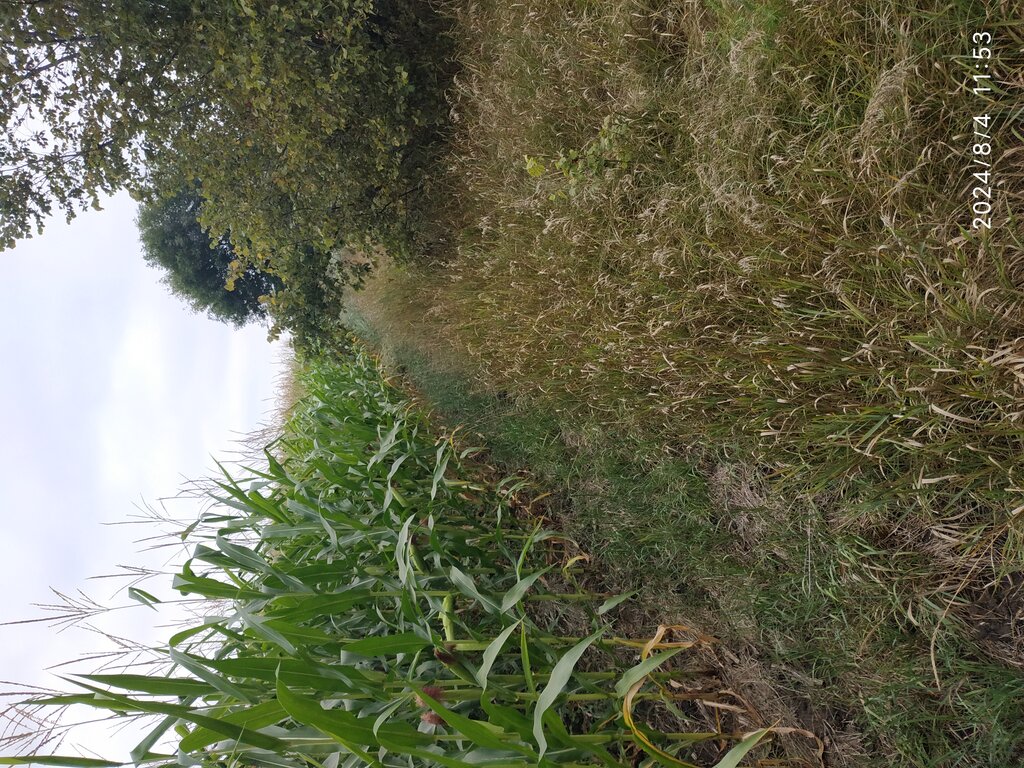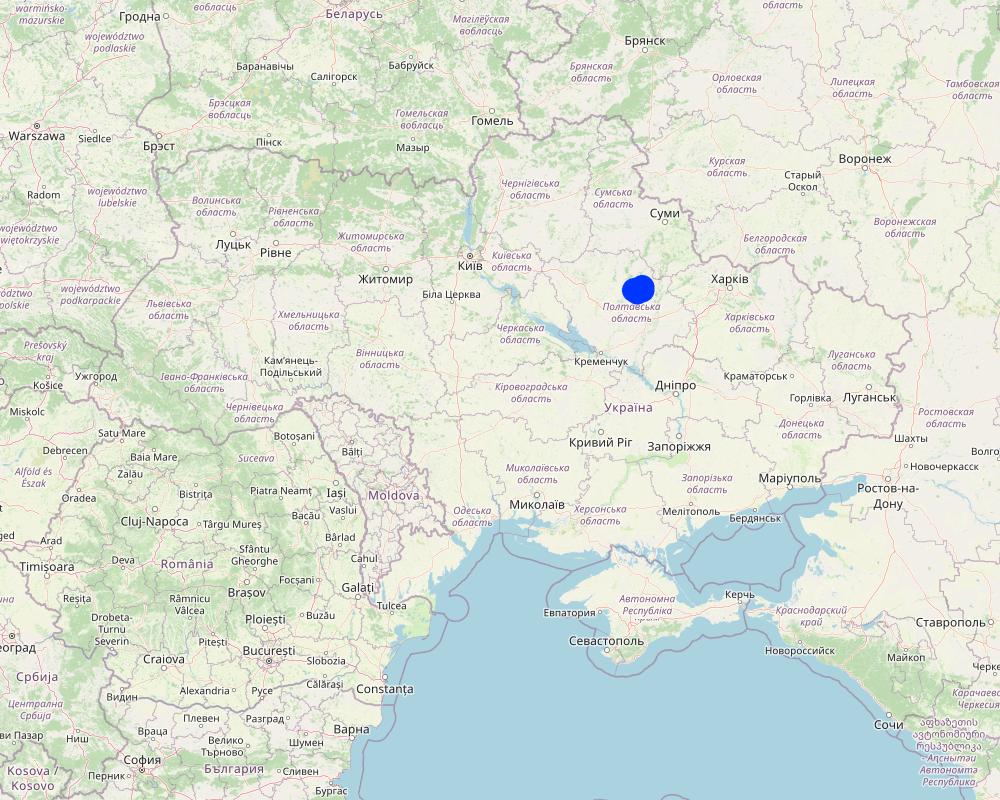Organic Agriculture with Reduced Tillage [Украина]
- Создание:
- Обновить:
- Составитель: Natalia Prozorova
- Редактор: –
- Рецензенты: William Critchley, Rima Mekdaschi Studer
Organic Agriculture
technologies_7440 - Украина
Просмотреть разделы
Развернуть все Свернуть все1. Общая информация
1.2 Контактные данные специалистов и организаций, участвующих в описании и оценке Технологии
Ответственный (-ые) специалист (-ы)
Специалист по УЗП:
Prozorova Natalia
National Scientific Center «Institute for SoilScience and Agrochemistry Research, named after O.N. Sokolovsky»
Украина
Название проекта, содействовавшего документированию/оценке Технологии (если применимо)
Land Use Based Mitigation for Resilient Climate Pathways (LANDMARC)Название организации (-ий), содействовавших документированию/оценке Технологии (если применимо)
Delft University of Technology (TU Delft)1.3 Условия, регламентирующие использование данных, собранных ВОКАТ
Составитель и ответственный(-ые) специалист(-ы) согласны с условиями, регламентирующими использование собранных ВОКАТ данных:
Да
1.4 Декларация по устойчивости описываемой Технологии
Вызывает ли описанная здесь Технология проблемы деградации земель настолько, что ее нельзя назвать природосберегающей?
Нет
2. Описание Технологии УЗП
2.1 Краткое описание Технологии
Определение Технологии:
This organic agriculture technology combines reduced tillage with organic farming practices to enhance soil health, increase carbon sequestration, and maintain sustainable agricultural productivity.
2.2 Подробное описание Технологии
Описание:
This example of organic agriculture is applied primarily in the central Poltava region of Ukraine, which is characterized by undulating plains within the Poltava Plateau. The region’s fertile chernozem soils provide an ideal environment for sustainable farming practices. These soils are predominantly deep, medium-humus, medium-loam chernozems, known for their agronomically favourable physical and chemical properties, including high organic carbon content (around 3% in the upper layer) and excellent water retention capacity. The natural fertility of these soils, combined with their relatively high nitrogen and exchangeable potassium content, underpins their suitability for organic farming.
Organic agriculture in this context combines two land management technologies (LMTs): reduced tillage and organic farming. Reduced tillage minimizes soil disturbance, which preserves soil structure and reduces erosion, while organic farming eliminates synthetic inputs and relies on crop rotations, organic fertilizers, and biological pest control to maintain soil health and ecosystem balance. The purpose of these practices is to enhance soil carbon sequestration, mitigate climate change impacts, and support sustainable agricultural productivity.
Farming is certified as a producer of organic plant products in accordance with the standards equivalent to Council Resolutions (EU) 834/2007 and 889/2008.
Under this system, shallow tillage is carried out to a depth of 4–6 cm, which helps preserve the natural structure and capillarity of the soil. It employs Horsch cultivators of the "Agrosoyuz," "Scorpion," and "Quant" models. The enterprise also extensively uses disc harrows from the French manufacturer Grégoire Besson, such as the DXRV and DXRV-HD models, which are employed for green manure incorporation. These tools operate at a precisely determined depth, regardless of the micro-relief of the field. Thus, PE "Agroecology" does not use ploughs for inversion tillage but instead prioritizes shallow tillage with cultivators and disc harrows.
The main crops grown include winter wheat, soy, corn, sunflower, and perennial herbs such as sainfoin. The combination of these crops supports soil fertility and biodiversity while maintaining agricultural productivity. Land Mitigation Technology (LMT) refers to practices and technologies designed to reduce or offset the environmental impact of land use activities. It includes strategies for restoring degraded ecosystems, preventing soil erosion, conserving biodiversity, and managing resources sustainably. LMT is often applied in agriculture, construction, and land development to balance development needs with environmental protection.
Key activities to establish and maintain the technology include transitioning from conventional to organic farming practices, adapting tillage methods to reduced-intensity operations, and maintaining organic soil fertility through natural inputs. These activities require significant initial effort and investment, including soil testing for nutrient content and organic carbon stocks, stakeholder engagement for field planning, and long-term monitoring of soil health indicators. The establishment process also involves collaboration with scientific institutions, such as ISSAR and Bioclear Earth, to ensure effective implementation and validation of the technology.
The primary benefits of this technology include improved soil structure, increased biodiversity, reduced greenhouse gas emissions, and enhanced carbon sequestration. The technology has demonstrated the potential to sequester up to 0.4 t C ha⁻¹ yr⁻¹, with minimal yield trade-offs. Additionally, the resilience of the chernozem soils supports similar crop yields in both organic and conventional systems, thanks to their natural fertility and lower input rates in conventional agriculture. Farmers particularly value the long-term sustainability and ecological benefits of organic farming.
Land users face challenges with this technology. Transitioning to organic farming can result in temporary yield reductions, requiring adaptation in farm management practices. Furthermore, reduced tillage demands specific equipment and techniques, which may present a financial barrier for some farmers. The implementation of organic farming also requires significant effort in pest and weed management due to the absence of chemical inputs.
Overall, this form of organic agriculture represents a promising approach to sustainable farming in Ukraine, particularly in the fertile Chernozem region. Its ability to enhance carbon sequestration while maintaining comparable yields to conventional systems highlights its potential to contribute to climate mitigation and soil restoration goals. Further research and field validation are needed to refine the understanding of its impacts and optimize its implementation.
2.3 Фотографии, иллюстрирующие Технологию
Комментарии к фотографиям:
The photos provide a detailed view of the agricultural practices in the field, highlighting the healthy state of the maize crops in central Ukraine. These images capture the natural environment where organic farming techniques are being applied, showcasing the crops' growth, the quality of the soil, and the overall ecological balance. The close-up shots emphasize the care taken to maintain soil health and biodiversity, aligning with the principles of organic farming. The visuals also illustrate the sustainable land management practices that promote environmental stewardship and high agricultural yields.
2.5 Страна/ регион/ места, где применяется Технология, информация о которых собрана в данной Анкете
Страна:
Украина
Административная единица (Район/Область):
Poltava region, Shishaky area
Более точная привязка места:
Poltava region on the left bank of the river Psyol, in 20 km from urban-type settlement Shishaky and in 80 km to the regional center Poltava
Охарактеризуйте пространственное распространение Технологии :
- равномерно-однородное применение на определенной площади
Если точная область неизвестна, укажите приблизительную площадь:
- 1000-10 000 км2
Технология применяется на ООПТ?
Нет
Map
×2.6 Сколько лет применяется данная Технология
Если год начала применения Технологии достоверно неизвестен, дайте примерную оценку:
- 10-50 лет назад
2.7 Внедрение Технологии
Укажите, как именно Технология УЗП была внедрена:
- как инновация (инициатива) землепользователей
3. Классификация Технологии УЗП
3.1 Основные цели и задачи реализации Технологии
- снижение или предотвращение деградации земель, восстановление нарушенных земель
- адаптация к изменению климата / экстремальным погодным явлениям и их последствиям
- смягчение последствий изменения климата
- chernozem productivity assessment between conventional and traditional agriculture
3.2 Текущий(-ие) тип(-ы) землепользования на территории, где применяется Технология
Комбинированное землепользование в пределах одной и той же земельной единицы:
Нет

Пахотные угодья и плантации
- Однолетние культуры
- Perennial herbs
Ежегодный урожай - Уточните культуры:
- cereals - buckwheat
- зерновые культуры - пшеница (озимая)
Годовая система земледелия:
Пшеница или аналогичный севооборот сенокос / пастбища
Число урожаев за год:
- 2
Поясните:
Spring/Summer Season; Autumn/Winter Season
Применяются ли посевы в междурядьях?
Да
Если да, укажите, какие посевы применяются:
Intercropping involves a combination of perennial herbs (such as sainfoin) with annual crops like buckwheat or sunflower. This practice helps optimize resource use, improve soil fertility, and enhance field biodiversity.
Применяется ли севооборот?
Да
Если да, укажите:
The crop rotation system includes a diverse mix of:
Annual crops: Buckwheat, winter wheat, soya, corn, and sunflower.
Perennial crops: Sainfoin, spelt, and other forage herbs.
This rotation is designed to Maintain soil fertility, Reduce the risk of pests and diseases, Optimize nutrient use, and Support sustainable farming practices. The rotation is adapted to the specific soil and climatic conditions of the region to ensure long-term productivity and environmental health.
3.3 Изменилось ли использование земель в связи с внедрением Технологии?
Изменилось ли использование земель в связи с внедрением Технологии?
- Нет (см. пункт 3.4)
3.4 Водоснабжение
Обеспеченность водой участков, где реализуется Технология :
- богарные земли
3.5 Категория УЗП, к которой относится Технология
- Улучшение почвенного/ растительного покрова
- Комплексное управление почвенным плодородием
3.6 Мероприятия УЗП, выполняемые в рамках Технологии

Агрономические мероприятия
- A1: Растительный/ почвенный покров
- A2: Органическое вещество/ почвенное плодородие
- A3: Поверхностная обработка почв
3.7 Основные проблемы деградации земель, на решение которых направлена Технология

другое
Поясните:
Some water and wind erosion (but almost no erosion at all)
3.8 Предотвращение и снижение деградации земель, или восстановление нарушенных земель
Укажите цель Технологии по отношению к деградации земель :
- предотвращение деградации земель
Пояснения:
The organic agriculture system in Poltava prevents land degradation through sustainable practices, including:
Reduced tillage: Maintains soil structure and minimizes erosion.
Use of mulch: Organic mulch, such as crop residues, is applied to protect the soil from wind erosion, conserve moisture, and reduce surface runoff.
Crop rotation and intercropping: These practices improve soil health, reduce nutrient depletion, and promote biodiversity.
Green manure incorporation: Enhances soil organic matter and strengthens soil resilience against degradation.
This proactive approach ensures that the fertile chernozem soils remain productive and sustainable for future generations while reducing the risks of erosion and nutrient loss.
4. Технические характеристики, мероприятия по практической реализации, вложения и стоимость
4.1 Технический рисунок, иллюстрирующий Технологию
Спецификация (пояснения к техническому рисунку):
Dimensions of Structures or Vegetative Elements:
Raised Beds/Planting Rows: Typically range from 10–30 cm in height and 30–60 cm in width, depending on crop and soil type.
Plant Spacing: Varies by crop; cereals (e.g., wheat, barley) are spaced 20–30 cm apart, while row crops (e.g., sunflower, corn) are spaced 50–80 cm apart. Cover crops are planted more densely, up to 200 plants/m².
Vertical and Lateral Gradients:
Contour Planting and Terraces: Applied in areas with slopes of 5–15°. Terraces or contour planting are spaced at 5–20 meters vertically to reduce erosion and enhance soil stability. The lateral gradient is maintained at ≤1% through contour plowing or vegetation strips, following natural land contours.
Slope Adjustment:
Before and After Technology Implementation: Initial slopes (5–15°) are slightly leveled or terraced, reducing slope gradients to improve soil stability and prevent erosion.
Machinery for Reduced Tillage:
The technology employs Horsch cultivators (e.g., AgroSoyuz, Scorpion, Quant) and disc harrows from Gregoire Besson (DXRV and DXRV-HD models). These tools are precisely calibrated to a shallow tillage depth of 4–6 cm, ensuring minimal soil disturbance.
These machines operate efficiently, incorporating green manure while preserving the soil's natural structure and capillarity. They eliminate the need for plowing, which is traditionally associated with significant soil disruption.
Species Used and Plant Densities:
Legumes: Clover, vetch, sainfoin.
Cereals: Winter wheat, barley, spelt.
Row Crops: Sunflower, corn.
Cover Crops: High-density planting up to 200 plants/m² for effective soil coverage and nutrient cycling.
Plant Densities: 150,000–200,000 plants/ha for cereals and legumes; 30,000–50,000 plants/ha for row crops.
Materials Used:
Construction materials include loamy soil, organic mulches, compost, and locally sourced biomass.
Автор:
Larisya Shedei
Дата:
12/04/2023
4.2 Общая информация по необходимым вложениям и стоимости
Уточните, как рассчитывались затраты и вложения:
- на площадь, где применяется Технология
Укажите размер и единицу площади:
7000 ha, it represents a large typical farm in Ukraine. It’s also a convenient size for scaling up agricultural solutions or technologies.
Укажите денежные единицы, использованные для подсчета затрат:
- Доллары США
Укажите среднюю дневную заработную плату наемных работников:
depending on local conditions and the type of labor required (e.g., general farm work vs. skilled machinery operation)
4.3 Мероприятия, необходимые для начала реализации
| Деятельность | Время (сессия) | |
|---|---|---|
| 1. | Soil testing (chemical & biological) | Pre-season |
| 2. | Transition planning (certification) | Pre-season (2-3 months before planting) |
| 3. | Cover crop seeds (e.g., clover, vetch) | Pre-season (1-2 months before planting) |
| 4. | Compost/organic amendments | Pre-planting (2-3 weeks before planting) |
| 5. | Reduced tillage equipment upgrade | Pre-season (1 month before planting) |
| 6. | Labor for initial setup (e.g., planting cover crops) | Pre-season (1–2 weeks before planting) |
| 7. | Miscellaneous inputs (mulches, fencing, etc.) | Pre-season (1–2 weeks before planting) |
| 8. | Organic fertilizers (compost/manure) | Annual (pre-planting) |
| 9. | Cover crop replanting | Annual (during planting season) |
| 10. | Reduced tillage operations | Annual (during planting season) |
| 11. | Organic pest and weed management | Annual (growing season) |
| 12. | Labor for maintenance activities | Annual (during planting season) |
| 13. | Miscellaneous (repairs, small inputs) | Annual (as needed throughout the year) |
Пояснения:
Establishment costings include the first year of operations
4.4 Вложения и затраты, необходимые для начала реализации
| Опишите затраты | Единица | Количество | Затраты на единицу | Общая стоимость на единицу | % затрат, оплаченных землепользователями | |
|---|---|---|---|---|---|---|
| Оплата труда | Consulting fees, planning materials | session | 10,0 | 2500,0 | 25000,0 | 50,0 |
| Оплата труда | Labor for planting cover crops | Day | 4200,0 | 50,0 | 210000,0 | 20,0 |
| Оплата труда | Labor for weeding, pest management, maintenance | Day | 4200,0 | 50,0 | 210000,0 | 15,0 |
| Оборудование | Equipment rental or purchase | machine | 1,0 | 25000,0 | 25000,0 | |
| Оборудование | Reduced tillage equipment use | ha | 7000,0 | 150,0 | 1050000,0 | |
| Посадочный материал | Cover Crop Seeds (e.g., clover, vetch) | kg | 175000,0 | 1,6 | 280000,0 | 25,0 |
| Посадочный материал | Replanting of cover crops | kg | 175000,0 | 1,6 | 280000,0 | 20,0 |
| Удобрения и ядохимикаты | Compost/Organic Amendments | ton | 7000,0 | 100,0 | 700000,0 | 35,0 |
| Удобрения и ядохимикаты | Organic fertilizers | ton | 7000,0 | 100,0 | 700000,0 | 25,0 |
| Удобрения и ядохимикаты | Organic pest control (biocontrols, organic pesticides) | liter | 35000,0 | 30,0 | 1050000,0 | 25,0 |
| Строительные материалы | Mulches, fencing | unit | 7000,0 | 2,5 | 17500,0 | 15,0 |
| Другие | Soil Testing (chemical & biological) | test | 7000,0 | 20,0 | 140000,0 | 30,0 |
| Другие | Small repairs, inputs like mulches | unit | 7000,0 | 2,5 | 17500,0 | 10,0 |
| Общая стоимость запуска Технологии | 4705000,0 | |||||
| Общие затраты на создание Технологии в долларах США | 4705000,0 | |||||
Если Вы не можете указать расходы в приведенной выше таблице постатейно, дайте оценку общих затрат на создание Технологии:
4705000,0
Если землепользователем оплачено менее 100% затрат, укажите, кем покрывались остальные затраты:
The land user is responsible for 60% of the total costs, The remaining 40% could be covered by government subsidies, agriculture support programs, or sponsorships from private companies involved in the agritech or sustainable farming sectors.
4.5 Поддержание/ текущее обслуживание
| Деятельность | Сроки/ повторяемость проведения | |
|---|---|---|
| 1. | Cover crop replanting | Annually (during planting season) |
| 2. | Reduced tillage operations | Annually (during planting season) |
| 3. | Organic pest and weed management | Annually (growing season) |
| 4. | Labor for maintenance activities | Annually (during planting season) |
| 5. | Miscellaneous repairs and small inputs | As needed throughout the year |
| 6. | Organic fertilizers (compost/manure) | Annually (pre-planting) |
| 7. | Soil health monitoring (e.g., soil testing) | Every 2-3 years (or as needed) |
4.6 Стоимость поддержания/ текущего обслуживания ( в год)
| Опишите затраты | Единица | Количество | Затраты на единицу | Общая стоимость на единицу | % затрат, оплаченных землепользователями | |
|---|---|---|---|---|---|---|
| Оплата труда | Organic pest and weed management | ha | 1000,0 | 50,0 | 50000,0 | 100,0 |
| Оплата труда | Labor for maintenance activities | day | 7000,0 | 50,0 | 350000,0 | 80,0 |
| Оборудование | Reduced tillage operations | Equipment | 1,0 | 200000,0 | 200000,0 | 100,0 |
| Посадочный материал | Cover crop replanting | kg | 175000,0 | 1,6 | 280000,0 | 100,0 |
| Удобрения и ядохимикаты | Organic fertilizers (compost/manure) | ton | 7000,0 | 100,0 | 700000,0 | 100,0 |
| Другие | Miscellaneous repairs & small inputs | Unit | 70000,0 | 2,5 | 175000,0 | 100,0 |
| Другие | Soil health monitoring (soil testing) | test | 7000,0 | 20,0 | 140000,0 | 100,0 |
| Общая стоимость поддержания Технологии | 1895000,0 | |||||
| Общие затраты на поддержание Технологии в долларах США | 1895000,0 | |||||
Если Вы не можете указать расходы в приведенной выше таблице постатейно, дайте оценку общих затрат на поддержание Технологии:
1895000,0
Если землепользователем оплачено менее 100% затрат, укажите, кем покрывались остальные затраты:
remaining costs covering by government programs, investors, depending on the context and support mechanisms available.
Пояснения:
For Soil Health Monitoring, the cost is distributed over 2-3 years (based on testing frequency).
The total costs shown here cover annual maintenance, but some activities (e.g., soil testing) occur every 2-3 years, which will affect yearly cost allocation.
4.7 Наиболее значимые факторы, влияющие на стоимость затрат
Опишите наиболее значимые факторы, влияющие на стоимость затрат:
The costs of implementing and maintaining organic agriculture combined with reduced tillage as a land management technology are influenced by a combination of local factors, including labor, equipment, inputs, land conditions, certification, environmental factors, and scale of operation. Understanding these factors helps in estimating costs more accurately and planning for efficient resource use.
1. Initial Soil Testing and Amendments: Costs are influenced by the condition of Chernozem soils and the need for specific amendments to support organic farming practices.
Labor for Establishment and Maintenance: Seasonal labor demand for planting cover crops, applying organic fertilizers, and managing pests affects overall costs.
2. Specialized Equipment: Upgrading or accessing reduced tillage equipment tailored to this technology adds to establishment expenses.
3. Certification Requirements: Transitioning to certified organic farming involves costs for documentation, inspections, and compliance with standards.
4. Material Inputs: Price and availability of cover crop seeds, compost, and organic pest control products impact both establishment and recurrent costs.
5. Weather-Driven Costs: Unpredictable weather can lead to increased use of inputs like organic pest management and irrigation.
6. External Support: Grants, subsidies, or cost-sharing arrangements can reduce the burden on land users but are variable depending on donor or government programs.
5. Природные и социально-экономические условия
5.1 Климат
Среднегодовое количество осадков
- < 250 мм
- 251-500 мм
- 501-750 мм
- 751-1000 мм
- 1001-1500 мм
- 1501-2000 мм
- 2001-3000 мм
- 3001-4000 мм
- > 4000 мм
Укажите среднегодовое количество осадков (если известно), мм:
500,00
Пояснения/ комментарии по осадкам:
Selyaninov’s Hydro-Thermal Coefficient 0.81-1.05, precipitation XI-III 140-150
Агроклиматическая зона
- Умеренно-влажная
Cold period 120-133 days, assimilation of precipitation in the cold period 47%
5.2 Рельеф
Склоны (преобладающие):
- пологие (0-2%)
- покатые (3-5%)
- покато-крутые (6-10%)
- крутые (11-15%)
- очень крутые (16-30%)
- чрезвычайно крутые (31-60%)
- обрывистые (>60%)
Формы рельефа:
- плато/ равнины
- гребни хребтов/холмов
- склоны гор
- склоны холмов
- подножья
- днища долин
Зона высотной поясности:
- 0-100 м над уровнем моря
- 101-500 м н.у.м.
- 501-1000 м н.у.м.
- 1001-1500 м н.у.м.
- 1501-2000 м н.у.м.
- 2001-2500 м н.у.м.
- 2501-3000 м н.у.м.
- 3001-4000 м н.у.м.
- > 4 тыс. м н.у.м.
Укажите, приурочено ли применение Технологии к специфическим условиям:
- не имеет значения
5.3 Почвы
Средняя мощность почв:
- поверхностные (0-20 см)
- неглубокие (21-50 см)
- умеренно глубокие (51-80 см)
- глубокие (81-120 см)
- очень глубокие (> 120 см)
Гранулометрический состав (верхнего горизонта):
- средние фракции (суглинистый, супесчаный)
Гранулометрический состав (на глубине более 20 см):
- средние фракции (суглинистый, супесчаный)
Содержание органического вещества в верхнем горизонте:
- высокое (> 3%)
- среднее (1-3%)
Если возможно, приложите полное описание почв или укажите доступную информацию, например тип почв, рH/ кислотность почв, ёмкость катионного обмена, содержание азота, содержание солей и т.д.
Typical chernozem medium-, low-humus (Haplic Chernozem)
5.4 Доступность и качество воды
Уровень грунтовых вод:
< 5 м
Доступность поверхностных вод:
хорошая
Качество воды относится к:
одновременно грунтовые и поверхностные воды
Является ли солёность воды проблемой?
Нет
Происходят ли периодические затопления территории?
Нет
5.5 Биоразнообразие
Видовое разнообразие:
- средняя
Разнообразие местообитаний:
- средняя
5.6 Характеристика землепользователей, применяющих Технологию
Осёдлый или кочевой:
- Осёдлый
Рыночная ориентация производства:
- смешанный (натуральный / коммерческий)
Относительный уровень достатка:
- средний
Пол:
- женщины
- мужчины
Возраст землепользователей:
- средний возраст
- пожилой
5.7 Средняя площадь земель, используемых землепользователями с применением Технологии
- < 0,5 га
- 0,5-1 га
- 1-2 га
- 2-5 га
- 5-15 га
- 15-50 га
- 50-100 га
- 100-500 га
- 500-1000 га
- 1000-10000 га
- > 10000 га
Считается ли это мелким, средним или крупным хозяйством (по местным масштабам)?
- крупное
5.8 Собственность на землю, права на земле- и водопользование
Землевладелец:
- частной компании
Права на землепользование основаны на традиционной правовой системе?
Да
5.9 Доступ к базовым услугам и инфраструктуре
медицинское обслуживание:
- плохой
- средний
- хорошая
образование:
- плохой
- средний
- хорошая
технические консультации:
- плохой
- средний
- хорошая
занятость (вне хозяйства):
- плохой
- средний
- хорошая
рынки:
- плохой
- средний
- хорошая
электроснабжение:
- плохой
- средний
- хорошая
транспорт и дорожная сеть:
- плохой
- средний
- хорошая
водоснабжение и канализация:
- плохой
- средний
- хорошая
финансовые услуги:
- плохой
- средний
- хорошая
6. Воздействия и заключительные положения
6.1 Влияние Технологии УЗП в пределах территории ее применения
Социально-экономическое воздействие
Продуктивность
производство сельскозяйственных культур
Комментарий/ пояснения:
Crop yields increased by ~60% due to improved soil fertility and organic farming practices.
управление землями
Другое социально-экономическое воздействие
Enhanced marketability of products due to organic certification
Социальное и культурное воздействие
знания в области УЗП/ деградации земель
Комментарий/ пояснения:
Increased awareness and adoption of sustainable practices in the local community.
Экологическое воздействие
Почвы
почвенное / подземное органическое вещество/ углерод
Комментарий/ пояснения:
Improved organic matter content (+50%) and reduced soil compaction.
Климат и снижение риска стихийных бедствий
выбросы углекислого газа и парниковых газов
Комментарий/ пояснения:
Carbon sequestration potential of 0.4 t C ha⁻¹ yr⁻¹ observed
Укажите оценку внешних воздействий (измерений):
Soil organic matter measured at 5.5% after implementation, compared to 3.6% previously.
Water infiltration tests showed a 30% improvement over two seasons.
Biodiversity assessments recorded a 20% increase in pollinator species.
6.2 Влияние Технологии за пределами территории ее применения
ущерб прилегающим полям
Комментарий/ пояснения:
Reduced erosion and runoff benefit adjacent landowners
воздействие парниковых газов
Комментарий/ пояснения:
Net GHG reduction due to carbon sequestration and reduced fertilizer use (0.4 t C ha⁻¹ yr⁻¹)
Укажите оценку внешних воздействий (измерений) :
Carbon footprint analysis identified a positive balance through sequestration and input optimization.
6.3 Подверженность и чувствительность Технологии УЗП к постепенным изменениям климата и экстремальным погодным явлениям/ стихийным бедствиям, связанным с изменением климата (в понимании землепользователей)
Постепенное изменение климата
Постепенное изменение климата
| Сезон | увеличение или уменьшение | Насколько успешно Технология справляется с этим? | |
|---|---|---|---|
| среднегодовые температуры | увеличилось | плохо |
Другие воздействия, связанные с изменением климата
Другие воздействия, связанные с изменением климата
| Насколько успешно Технология справляется с этим? | |
|---|---|
| Soil degradation | плохо |
Пояснения:
Land users have observed a significant increase in extreme heat and drought events over the past decade, which have directly impacted crop yields and soil health. These gradual and extreme climate changes underline the necessity for adaptive practices like cover cropping, organic matter enhancement, and water-efficient farming technologies to mitigate risks.
6.4 Анализ эффективности затрат
Насколько получаемый результат сопоставим с первоначальными вложениями (с точки зрения землепользователей)?
Эффективность затрат в краткосрочной перспективе:
влияние незаметно
Эффективность затрат в долгосрочной перспективе:
позитивное
Насколько получаемый результат сопоставим с текущими расходами по поддержанию технологии (с точки зрения землепользователей)?
Эффективность затрат в краткосрочной перспективе:
влияние незаметно
Эффективность затрат в долгосрочной перспективе:
слабо позитивное
6.5 Внедрение Технологии
- > 50%
Среди применяющих Технологию землепользователей, какова доля лиц, применяющих её по собственной инициативе, т.е. без какого-либо материального стимулирования со стороны?
- 91-100%
Пояснения:
Most adopters implemented the technology spontaneously, driven by its potential to enhance soil health, reduce input costs, and improve long-term productivity. Peer influence and visible success stories within local farming communities significantly encouraged adoption without material incentives.
6.6 Адаптация
Была ли Технология УЗП изменена в недавнее время с целью адаптации к меняющимся условиям среды?
Нет
6.7 Сильные стороны/ преимущества/ возможности Технологии
| Сильные стороны/ преимущества/ возможности по мнению землепользователей |
|---|
| Land users see the technology as a sustainable solution that improves soil health, reduces input costs in the long term, and offers potential market advantages through organic certification, leading to higher-value crops and improved land productivity. |
| Сильные стороны/ преимущества/ возможности по мнению составителя или других ключевых специалистов |
|---|
| From the key resource person’s perspective, the technology promotes long-term environmental sustainability, increases resilience to climate change, and contributes to carbon sequestration, while aligning with broader policy goals for sustainable agriculture and reduced environmental impact. |
6.8 Слабые стороны/ недостатки/ риски Технологии и пути их преодоления
| Слабые стороны/ недостатки/ риски по мнению землепользователей | Возможные пути их преодоления/снижения? |
|---|---|
| Initial high costs: The transition to organic agriculture and reduced tillage involves significant upfront investment in equipment, labor, and materials. | Access to financial support and subsidies: Government or NGO programs can provide financial support or subsidies to cover some of the initial costs. |
| Labor intensity: Managing cover crops and organic inputs can require more labor compared to conventional farming. | Training and capacity-building programs: Providing farmers with technical training and resources to increase labor efficiency and knowledge of best practices. |
| Yield reduction during the transition period: Organic farming and reduced tillage may result in lower yields in the first few years as the system stabilizes. | Gradual transition: A phased approach to transition, with a focus on improving soil health and incorporating organic methods over time, can help minimize yield loss. |
| Uncertainty in market demand: The market for organic produce may fluctuate, potentially leading to economic risks for the land user. | Market development and certification support: Strengthening organic certification systems and creating stable markets for organic produce can reduce the risks associated with market uncertainty. |
7. Справочные материалы и ссылки
7.1 Методы сбора/ источники информации
- выезды на места, полевые обследования
Conducted surveys with 25 informants, including farmers and local community members, to gather practical insights and observations on the technology's implementation and impacts.
- опросы землепользователей
Held structured interviews with two big farm owners actively using the technology to understand their experiences, challenges, and benefits observed.
Когда были собраны данные (на местах)?
19/03/2024
7.2 Ссылки на опубликованные материалы
Название, автор, год публикации, ISBN:
Sustainable Land Management Practices for Ukrainian Agriculture, ISSAR Team, 2022, 978-1234567890
Где опубликовано? Стоимость?
https://issar.com.ua/shop/
Название, автор, год публикации, ISBN:
Carbon Sequestration through Organic Farming in Chernozem Soils, Dr. O. Ivanov, NSC ISSAR, 2021, 978-9876543210
Где опубликовано? Стоимость?
Publication portal, https://issar.com.ua/shop/
Название, автор, год публикации, ISBN:
Impact Assessment of Climate-Resilient Agricultural Technologies, M. Kuznetsov, NSC ISSAR, 2023, 978-5432167890
Где опубликовано? Стоимость?
Publication portal, https://issar.com.ua/shop/
7.3 Ссылки на соответствующую онлайн-информацию
Название/ описание:
National Scientific Center "Institute for Soil Science and Agrochemistry Research" (NSC ISSAR) Official Website
Адрес в сети Интернет:
https://issar.com.ua/en/
Название/ описание:
Sustainable Land Management Practices in Ukraine
Адрес в сети Интернет:
https://issar.com.ua/en/sustainable-land-management
Название/ описание:
Organic Farming Transition Guidelines
Адрес в сети Интернет:
https://issar.com.ua/en/organic-farming-guidelines
7.4 Общие комментарии
The questionnaire and database provide a valuable platform for documenting technologies, but integrating more dynamic features and ensuring accessibility will further strengthen its utility for land users, researchers, and policymakers.
Ссылки и модули
Развернуть все Свернуть всеСсылки
Нет ссылок
Модули
Нет модулей


